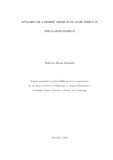| dc.contributor.author | Makwata Harun Omukuba, Harun Makwata | |
| dc.date.accessioned | 2019-12-02T08:13:09Z | |
| dc.date.available | 2019-12-02T08:13:09Z | |
| dc.date.issued | 2019-11 | |
| dc.identifier.uri | http://r-library.mmust.ac.ke/123456789/1338 | |
| dc.description.abstract | Sustainable exploitation of renewable resources such as marine sh has been a con-
cern to both ecologists and economists with threats of species extinction due to over
- exploitation a stark reality. Fish exhibits co-operative and social characteristics
among individuals which increases its survival through predator surveillance and
enhanced spawning. Over shing compromises this con - speci c interactions and
socialism. In this study, a mathematical model of a shery with an Allee e ect in
the population growth equation is developed. This is achieved by formulation of
a set of ordinary di erential equations governing the evolution in the population
growth, harvesting e ort and the stock market price. The model is aggregated to
reduce its dimensions from a system of three equations to a system of two equa-
tions since market price is taken to evolve faster. Four equilibrium points are
obtained, and analysed using local stability and local bifurcation. Simulation of
the model for equilibrium points with zero harvesting is performed using MATLAB
while further stability analysis, at three di erent values of the threshold population
is carried out yielding three di erent cases of equilibrium solutions; Stable equi-
librium, co-existence of three positive equilibria two being saddles and the other
being stable and the co-existence of three positive equilibria with two being stable
separated by a saddle. The stable equilibrium corresponds to the case of a shery
with the sh stock at high levels with a small economic activity, the harvesting is
artisanal with low economic returns. The co-existence of three positive equilibria,
two being saddles and the other being stable corresponds to a shery where, sh-
ery management practices of monitoring, control and surveillance are practised,
hence exploited in a sustainable manner. Finally, the co-existence of two stable
equilibria points separated by a saddle corresponds to co-existence of two kinds
of shery; an over- exploited shery with a large economic activity with the stock
facing extinction and an under - exploited shery with a small economic activity
with the stock maintained at high levels far from extinction. Bifurcation diagrams
obtained show how equilibria changes from stable to unstable at critical value of
the carrying capacity as the sh population and harvesting e ort vary. From the
analysis, setting of appropriate shery management practices like shing quotas,
shall guide sustainable exploitation of the Kenya commercial marine sh species.
This shall be enhanced by more monitoring on sh stock density and total catches. | en_US |
| dc.description.sponsorship | MMUST | en_US |
| dc.language.iso | en | en_US |
| dc.publisher | MMUST | en_US |
| dc.subject | Sustainable,exploitation,renewable, resources,ecologists,economists, threats,species ,extinction | en_US |
| dc.title | DYNAMICS OF A FISHERY MODEL WITH ALLEE EFFECT IN POPULATION GROWTH | en_US |
| dc.type | Thesis | en_US |

